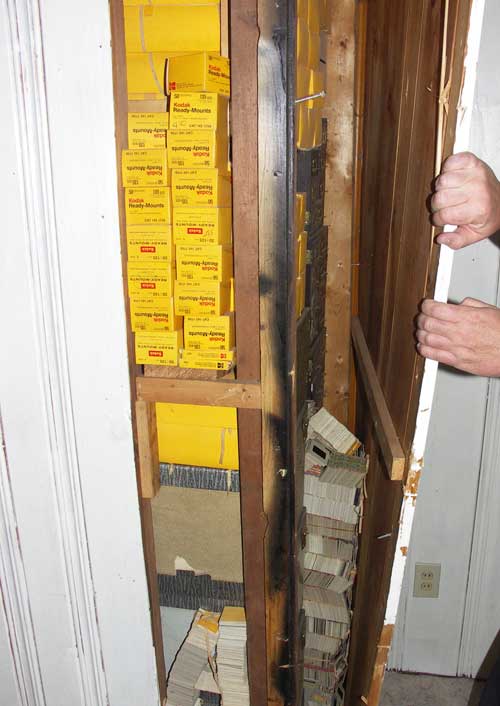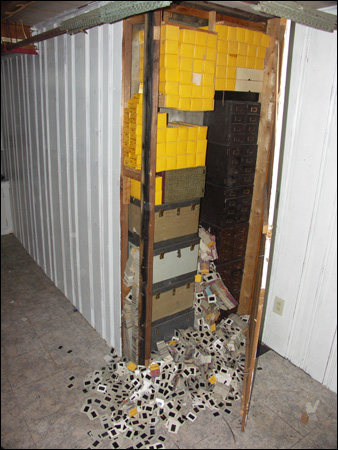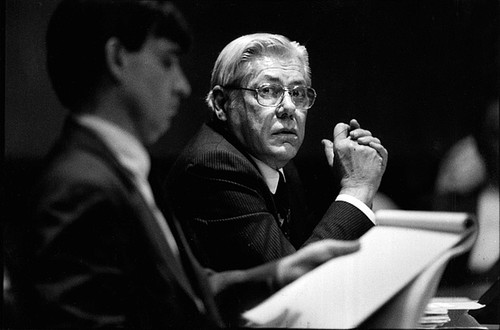By Daniel P. Jones
Hartford Courant
November 30, 2007
http://www.courant.com/news/custom/topnews/hc-reardon1130.artnov30,0,252071.story
WEST HARTFORD — - Local police have fielded dozens of calls from people who say they were sexually abused or inappropriately photographed by Dr. George E. Reardon following the announcement that a huge cache of child pornography was discovered in the basement of his former home.
"We've been taking phone calls most of the day," Capt. Lori Coppinger said Thursday.
The people who say they were childhood victims began telling their stories to detectives, who have been swamped by calls since police announced Wednesday that thousands of 35mm slides and 8mm video reels of child pornography were found in May, hidden behind paneled basement walls in Reardon's former home on Griswold Drive.
 |
| West Hartford police Wednesday announced that in May a homeowner on Griswold Drive renovating the basement found a large quantity - 50,000 35-mm slides and more than 100 8-mm video reels - of child pornography hidden in a secret storage area in the home, which was previously owned by Dr. George Reardon, a former chief of endocrinology at St. Francis Hospital and Medical Center in Hartford with a troubled history. |
The prominent West Hartford endocrinologist was accused in the late 1980s and early 1990s of molesting children over several decades, including incidents at his office at St. Francis Hospital and Medical Center in Hartford. He died nine years ago.
Police are hoping that by identifying people shown in the slides and videos, it will allow authorities to prosecute anyone found in possession of the images. Investigators also hope to determine whether any of Reardon's images match those in a national database, which could enable prosecutions anywhere in the country.
 |
| Police are trying to identify victims pictured in a huge child pornography cache of slides and videos found at a home in West Hartford. |
By late afternoon Thursday, nearly 50 people had called West Hartford police to say they were victimized by Reardon. All 12 detectives in the department were pressed into service to take their calls, said Lt. Donald Melanson, one of the investigators.
The callers range in age from their 30s to their 60s, Melanson said, and come from all walks of life.
"The stories, for the most part, are all very consistent," Melanson said. "The common theme that we gather is that abuses have affected every aspect of their lives."
Police say the number of victims pictured among the thousands of images appears to be in the hundreds.
Reardon, who was chief of endocrinology at St. Francis, was accused in state medical hearings in the early 1990s of molesting and inappropriately photographing children over several decades, starting in the 1950s.
 |
| Dr. George E. Reardon, who died in 1998, listens to testimony in 1993 at the Legislative Office Building in Hartford that he had sexually abused a brother and sister. Photo by Michael McAndrews |
A brother and sister filed the first two complaints against Reardon with state health authorities in 1987, alleging that he had abused them between 1956 and 1961 when they were 5 and 7, respectively. Reardon was practicing in Albany at the time. In 1989, a Hartford woman said she had been abused 14 years earlier, when she was 10. A fourth complaint came in 1993 from the Hartford County Medical Association on behalf of a woman who said Reardon had sexually abused her when she was 14.
Neither the state nor St. Francis took action against Reardon until the fourth complaint.
He retired in 1995 and agreed to stop practicing medicine.
Reardon died of a heart attack in September of 1998, and his former home has been sold twice since then. The current owner of the Griswold Drive home discovered the pictures while doing basement renovations May 20, and alerted police. The homeowners did not respond to requests for an interview.
During the past several months, investigators have been sorting through the images now stored in a locked room separate from the police department's main evidence room, Coppinger said.
The investigators have been working with the FBI and the National Center for Missing & Exploited Children to determine how to best go about identifying victims. The size of the once-secret cache — about 50,000 35mm slides and more than 100 8mm reels — presents a daunting organizational challenge. The investigators have been working with the FBI to convert the 8mm film to DVDs, and have converted some of the slides to digital pictures. Only a sample of the slides will be converted, Melanson said.
The conversions will allow police to work with the National Center For Missing & Exploited Children's database to look for possible matches indicating that Reardon's images were shared.
The investigators intend to protect the privacy of the victims, he said.
Victims who want to try to identify themselves in the images will be asked to find a photograph showing them at about the same age when Reardon abused them and took their pictures. Investigators will try to find facial matches among Reardon's images, using the photographs the victims produce, Melanson said.
If investigators find a plausible match, the image or images from Reardon's cache will be cropped to show only a face, and the victim will be asked to confirm the match, Melanson said.
Detectives, he said, have not yet taken steps to identify victims at this stage of the investigation.
When the investigation is completed and the images no longer have evidentiary value, the police would expect to destroy the pictures at the victims' request to protect their privacy, Melanson said.
For victims now coming forward, the images long hidden from view are both vindication of their accounts and reminders of a painful past.
In a lawsuit filed in the early 1990s, for example, a man said he was hospitalized at St. Francis for treatment of seizures when he was 5, according to a 1994 report in The Courant.
While at the hospital, he alleged, he was taken several times to Reardon's office, where he was fondled and photographed in the nude with another boy. The lawsuit said the man suffered "nightmares, recurrent and intrusive recollections of being wheeled down to [Reardon's] hospital office, crying and protesting."
Susan K. Smith, a lawyer who won settlements from the hospital's insurer for about a half-dozen of Reardon's victims, said children victimized by sexual abusers rarely forget the trauma. "This is a life-altering event, when this happens," she said.
Smith's clients sued Reardon.
Smith said she is evaluating whether potential clients could now sue the hospital, given that the statute of limitations has been changed to effectively allow people 48 or younger to sue in childhood sexual abuse cases. Victims would have to prove the hospital knew of his misconduct or should have known about it, she said.
Tina Varona, a hospital spokeswoman, has said that matters involving Reardon "occurred nearly 15 years ago, and would have involved individuals who are no longer at St. Francis. Because of this, we are not able to respond to questions as to what happened at that time."
Any original material on these pages is copyright © BishopAccountability.org 2004. Reproduce freely with attribution.